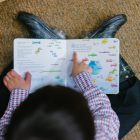The Pie Plate: Serving up a Slice of Travel through the Haibun Poetic Form
Guest post by Aimee Nezhukumatathil
Dear Reader, I am covered in ice and snow for most of the year. But summers here in Western New York mean a bevy of fresh fruit from any of the local cherry orchards, blueberry fields, or strawberry patches. I live within five miles from several farms that allow me to pick my own fruit. And where there is a bevy of fruit, there must be pies.
I love travel writing and one way to capture a “slice of travel” in a poem can be found in a haibun. The haibun is a Japanese poetic form, but is not a prose poem in itself. The haibun is a slice of a journey or destination, composed of a prose poem and it ends in a whisper of sorts: a haiku. The result is a very elegant looking block of text with the haiku serving as a tiny bowl or stand for the prose poem section. A whole series of them in a manuscript look like neat little signs or flags. A visual delight.
My favorite baking accoutrement is a red ceramic pie plate made by Williams-Sonoma. It was a housewarming gift from a turtle friend and poet–a guy who has no home himself: he carries all his possessions on his back. Can slip into the sea or sun himself on the beach whenever he pleases. He gave me this red shell–inverted, it’s a drum–the tink-tink-tink of cold ceramic and my spoon like a calling for dinner, and especially, what comes after. I love the promise of buttery crust and scoop of fruit. I love what it smells like: home.
Before I had my second baby, I was often away from home–a mint green rancher with a wild and sprawling lily garden–for various visiting writer gigs or to teach poetry workshops across the country. I found that writing haibun is a way for me to record my travel in a condensed and imagistic light, that is–to record both the beauty, danger, tragedy, adventure, etc., that we sometimes experience when we travel. Many writers of haibun start by keeping a daily journal of haibun, not about travel per se, but to record the previous day’s events. Other writers of haibun use the form to re-imagine fairy tales, or examine persona.
Now that my husband and I are juggling a newborn and a wily three-year-old, keeping a haibun journal and is a refreshing way to get some “morning pages” written first thing or last thing at night. Even on the days I feel too zombie-fied from late-night feedings, I can always at least manage a draft of a haibun. I’m amazed at what may seem like an ordinary week becomes almost magical from recording it haibun-style.
When you construct the prose-poem part of the haibun, this is your chance to take risks with syntax and diction that you normally wouldn’t do in a lineated poem. Try repeating phrases or single words. Write a really long sentence and make your next sentence a fragment. Repeat a motif–elements of light, a color, etc., throughout your poem. Try including an animal doing an unusual action–not one usually associated with that animal. For example, a dog barks. BO-ring! But a dog that walks the ceiling of your hostel room–now that will pique the reader’s curiosity. Try to go for a tone of play, of magic, but don’t go too far that the reader will be wondering if you are trying to do a bad imitation of Alice in Wonderland. The prose poem part of the haibun should at least have essential truth to it, not necessarily factual truth. In other words, it should at least ring true emotionally for your reader. Finally, end your haibun with a haiku (traditionally a 5-7-5 syllable count, but many contemporary haibun often vary in syllables). I like to think of the haiku as something of a letter’s postscript–adding a little something extra to finish the haibun with a quiet flourish.
Here’s a sample haibun from one of the best contemporary haibun writers, Jeannine Hall Gailey. Instead of describing travel, or a specific place, notice how she takes a Japanese folk-tale and re-imagines it through the use of persona and a particularly acute attention to sensory detail. The haibun is the perfect form for this, as Gailey displays here:
The Fox-Wife Describes Their CourtshipI had given up the world, given my body to death or any possible rebirth. When he found me at the shrine of Inari, I became something else. But when the smoke rose, it was still me, terrified, turning and turning from the heat. How could he quiet this new body, its voices and tears? When we’re alone, I forget my other life sometimes, forget my sharp teeth and tail. I become the thing beneath his hands, softer.We all wear our voices out calling for each other, and when does that song end? He loved the falling cherry blossoms, the crumpling peonies, the dying willow. He always sought to put things back together. I tear things apart. The instruments of bone and blood are the same; the intents are different. I look down and see my paw on his hand. He sees the half-moons of nails, the pink skin. He sees the hope in changing seasons, and I only see the leaves departed, the savage inky trails of the moon in the grass.I know before he doeshow he will leave me,a little temple of spine and fur.
I like teaching the haibun in particular for my students who claim they have never “gone anywhere interesting,” or haven’t traveled out of state, country, etc. I like to teach haibun as the last component in a poetry course or as the last form of poetry before we turn to fiction writing for the second half of the semester. All the rules and suggestions of what to keep in mind as one crafts a haibun make it especially freeing and fun to see what innovations the students come up with by “breaking” the rules of the haibun and seeing what hybrid writing is created by doing so.
Some believe the turtle carries the whole weight of the world. I want that turtle to put down his pack for once and join me at the table. I promise him here and now that the next pie made from this plate will pipe hot steamsongs. I want to capture my journey in haibun, each slice of a new city or new landscape brimmed with filling and sweetness. Let the grace of my hands form a crust so flakey and fine, my reader will forget his burden, his heavy step. He won’t remember whether or not he had seconds. Only the curve of his spoon, the simple lattice of berries.
This is Aimee’s sixth post for Get Behind the Plough.



